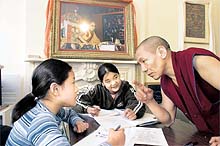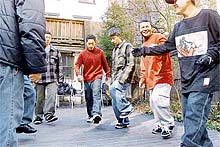
March 6, 2001
Tibetans Struggle to Preserve Culture, at Home and Abroad
By SUSAN SACHS
|
 lass begins with a Buddhist prayer for the world and ends with a song for Tibet. In between, Pema Dorjee, a diminutive monk in a sleeveless orange robe, darts among his students as they struggle with the characters of the Tibetan alphabet.
lass begins with a Buddhist prayer for the world and ends with a song for Tibet. In between, Pema Dorjee, a diminutive monk in a sleeveless orange robe, darts among his students as they struggle with the characters of the Tibetan alphabet.
None of the 15 or so Tibetan children who come to his Sunday language course in Manhattan have ever seen Tibet, the isolated mountain nation that China invaded in 1950 and forcibly absorbed. Nor have many of their parents, exiles who were born and raised in refugee settlements in India or Nepal. But Tibet is what — at least so far — holds them together as a group. "The children are our hope to preserve our culture," said Mr. Dorjee, a store clerk on weekdays. "They can keep Tibet alive." It is an uphill struggle.
As for other immigrants at other times, young Tibetans face multiple distractions and temptations in their new American lives. Maintaining the culture of home — and in the case of these Tibetan-Americans, a home twice removed — competes with the natural inclination to concentrate on managing a new culture.
But for Tibetans, the traditional tug of war is complicated by a real ambivalence on the part of their leadership toward their growing presence in the United States. In their political lobbying and fund-raising in the West, Tibetan exiles have argued for decades that Tibetan culture will die if Tibetans scatter across the globe.
"We have mixed feelings within ourselves," said Rinchen Dharlo, president of the Tibet Fund, an organization in New York that sponsors the language classes and raises money for the Indian and Nepalese resettlement camps. "I don't really worry here in the States, at least for this generation," he said. "It will all depend on whether our community stays together, as it does today, in clusters. If so, we will be able to keep our culture."
In just a decade, the number of Tibetan exiles in this country has increased more than tenfold. It is still a tiny group — barely 9,000 people in all, scattered over 30 cities — with the largest concentration of about 2,000 people in New York City. Another 2,000 Tibetan exiles are believed to live in Canada, Mr. Dharlo said.
Nearly invisible in the city's expanding and ever more diverse immigrant population, many of the Tibetans who are now living here came on visitors' visas and stayed. And like the city's other illegal immigrants, they have had to find jobs on the bottom tiers of the economy. Many Tibetan women work as nannies. Many men find jobs as store clerks or on construction sites.
Until the early 1990's, however, Tibetan exiles numbered in the few hundreds in North America, where they actively promoted their cause of freeing Tibet from Chinese rule. Then Congress presented the Dalai Lama, the spiritual leader of Tibetans, with the opportunity to legally resettle 1,000 people in the United States.
The offer caused consternation. "Many of our American friends said, `It's not good to bring too many Tibetans to the States, because this country is a melting pot,' " Mr. Dharlo said. But the Tibetan leadership eventually decided that the mythical melting pot was not what it might seem and that many immigrants, if they stay close together, succeed in preserving their language and, to some degree, their culture.
In any case, they concluded, the political advantages outweighed the risks of assimilation. "We thought that if we bring 1,000 Tibetans, they will be ambassadors in this country to make additional friends for Tibet," Mr. Dharlo said. "And if we are able to save the culture of six million Tibetans in Tibet, strengthen the Tibetan struggle and bring it closer to fruition, then it doesn't matter if these 1,000 Tibetans lose their identity in this country."
To some degree, young Tibetans are playing that ambassadorial role. "Nobody really knew anything about Tibet in my school, but I try to tell them," said Tashi Dorje, who is 15 and learning Tibetan dance at the Sunday school. "They ask me why Tibetans got kicked out of our own country. I tell them we are peaceful and we don't fight."
Still, in their own homes, many Tibetan parents are wrestling with those very dilemmas that had worried their leaders. They see their Buddhist faith and their Tibetan language buffeted daily by the simple fact of living among non-Tibetans. "Selfishness is very strong in this country," said Chunta Lama, who came to New York with her husband and young son from India three years ago. "And it's very materialistic. The moment you see all these material things, you may lose respect for your own culture."
Some children, as they become more like their American friends each day, even question elements of their religion, deeply shocking parents who could not have imagined debating such things with their elders. "They think this is blind faith," said Mrs. Lama, who brings her son to Sunday school every week and makes sure he practices writing Tibetan along with his regular homework. "They want to know why, in this age of computers and science, we believe what we believe."
But learning about Tibetan culture is not only a struggle for the young. Tenzin Wangyhl, one of the first refugees to come as part of the Congressional allotment, teaches traditional dances and songs on Sundays at the Tibet Fund's headquarters. What he knows, he learned from listening to old tapes after he arrived in New York in 1993 and from recent visits to Tibetan refugee camps in India.
"Recently, we've had some kids who have just arrived from India," Mr. Wangyhl said one recent Sunday, as he watched three teenage boys practice the Tibetan drum dance outside in the bitter cold. "They've kept up with it better than I was able to at that age."
As often happens with pioneering immigrants, those first refugees like Mr. Wangyhl sent for their families, as they were allowed to do under the law. But their presence inspired friends, distant relatives and others to come and join them. Many of those who arrived in the last few years came without valid documents, believing that the United States would grant them political asylum. That assumption, for most, has proved to be wrong.
The Immigration and Naturalization Service considers Tibetans stateless, but it has opposed most asylum requests from those who lived for most of their lives in Nepal or India. The agency's position, supported by immigration judges, is that an applicant must prove that he or she suffered or fears persecution in the country of last residence. Judges generally decide that India and Nepal treat Tibetan exiles well, lawyers who represent Tibetans say, even if those countries restrict or refuse to give citizenship to the refugees. Few asylum applications have been granted.
Canada, on the other hand, grants most asylum requests from Tibetans. And over the last three years, according to refugee agencies and Canadian lawyers, nearly 1,000 exiles who had been living in the New York area crossed the border and claimed asylum in Canada. Judges there generally rely on a different test for deciding whether a Tibetan exile faces persecution in the country of resettlement. They have repeatedly ruled that a Tibetan who does not have citizenship in India or Nepal runs the risk of one day being deported to China, which now controls Tibet.
"If you have no status in a country, you don't have a right to remain," said Constance Nakatsu, a Toronto lawyer who has represented many Tibetans seeking asylum in Canada. "And the Tibetans really don't have a home."

